Cyclodextrin-Grafted TiO2 Nanoparticles: Synthesis, Complexation Capacity, and Dispersion in Polymeric Matrices
Abstract
1. Introduction
2. Materials and Methods
2.1. Materials
2.2. Sample Preparation
2.2.1. Nanoparticles Surface Modification
2.2.2. Production of Polymeric Nanocomposites
2.3. Techniques
3. Results and Discussion
3.1. Characterization of the Nanoparticles Surface
3.2. Characterization of the Complexation Ability of the βCDTiO2 NPs
3.3. Characterization of the Effect of the Nanoparticles Dispersion within Polymeric Matrices
4. Conclusions
Author Contributions
Funding
Acknowledgments
Conflicts of Interest
References
- Jeon, I.-Y.; Baek, J.-B. Nanocomposites Derived from Polymers and Inorganic Nanoparticles. Materials 2010, 3, 3654–3674. [Google Scholar] [CrossRef]
- Hussain, F.; Hojjati, M.; Okamoto, M.; Gorga, R.E. Polymer-Matrix Nanocomposites, Processing, Manufacturing, and Application: An Overview. J. Compos. Mater. 2006, 40, 1511–1575. [Google Scholar] [CrossRef]
- Al-Saleh, M.H.; Sundararaj, U. Review of the Mechanical Properties of Carbon Nanofiber/Polymer Composites. Compos. Part A 2011, 42, 2126–2142. [Google Scholar] [CrossRef]
- Carr, J.M.; Langhe, D.S.; Ponting, M.T.; Hiltner, A.; Baer, E. Confined Crystallization in Polymer Nanolayered Films: A review. J. Mater. Res. 2012, 27, 1326–1350. [Google Scholar] [CrossRef]
- Smith, S.R.; Rafati, R.; Sharifi Haddad, A.; Cooper, A.; Hamidi, H. Application of Aluminium Oxide Nanoparticles to Enhance Rheological and Filtration Properties of Water Based Muds at HPHT Conditions. Colloid Surf. A 2018, 537, 361–371. [Google Scholar] [CrossRef]
- Guo, D.; Xie, G.; Luo, J. Mechanical Properties of Nanoparticles: Basics and Applications. J. Phys. D 2014, 47, 013001. [Google Scholar] [CrossRef]
- Yadav, H.K.S.; Alsalloum, G.A.; Al Halabi, N.A. Nanostructures for the Engineering of Cells, Tissues and Organs; William Andrew Publishing: Norwich, NY, USA, 2018; Volume 14, pp. 513–587. [Google Scholar]
- Rizvi, S.A.A.; Saleh, A.M. Applications of Nanoparticle Systems in Drug Delivery Technology. Saudi Pharm. J. 2018, 26, 64–70. [Google Scholar] [CrossRef] [PubMed]
- Premila, R.; Subbu, C.; Rajendran, S.; Kumar, K.S. Experimental Investigation of Nano Filler TiO2 Doped Composite Polymerelectrolytes for Lithium Ion Batteries. Appl. Surf. Sci. 2018, 449, 426–434. [Google Scholar] [CrossRef]
- Krishnan, N.N.; Lee, S.; Ghorpade, R.V.; Konovalova, A.; Jang, J.H.; Kim, H.-J.; Han, J.; Henkensmeier, D.; Han, H. Polybenzimidazole (PBI-OO) Based Composite Membranes Using Sulfophenylated TiO2 as Both Filler and Crosslinker, and Their Use in the HT-PEM Fuel Cell. J. Membr. Sci. 2018, 560, 11–20. [Google Scholar] [CrossRef]
- Schneider, J.; Matsuoka, M.; Takeuchi, M.; Zhang, J.; Horiuchi, Y.; Anpo, M.; Bahnemann, D.W. Understanding TiO2 Photocatalysis: Mechanisms and Materials. Chem. Rev. 2014, 114, 9919–9986. [Google Scholar] [CrossRef] [PubMed]
- Li, Z.; Cong, S.; Xu, Y. Brookite vs Anatase TiO2 in the Photocatalytic Activity for Organic Degradation in Water. ACS Catal. 2014, 4, 3273–3280. [Google Scholar] [CrossRef]
- Kobayashi, M.; Kalriess, W. Photocatalytic Activity of Titanium Dioxide and Zinc Oxide. Reproduction 1997, 112, 83–85. [Google Scholar]
- Zhao, J.; Chen, C.; Ma, W. Photocatalytic Degradation of Organic Pollutants under Visible Light Irradiation. Top. Catal. 2005, 35, 269–278. [Google Scholar] [CrossRef]
- Wang, J.; Li, C.; Zhuang, H.; Zhang, J. Photocatalytic Degradation of Methylene Blue and Inactivation of Gram-Negative Bacteria by TiO2 Nanoparticles in Aqueous Suspension. Food Control 2013, 34, 372–377. [Google Scholar] [CrossRef]
- Nieto Pozo, I.; Olmos, D.; Orgaz, B.; Božanić, D.K.; González-Benito, J. Titania Nanoparticles Prevent Development of Pseudomonas Fluorescens Biofilms on Polystyrene Surfaces. Mater. Lett. 2014, 127, 1–3. [Google Scholar] [CrossRef]
- Robertson, J.M.C.; Robertson, P.K.J.; Lawton, L.A. A Comparison of the Effectiveness of TiO2 Photocatalysis and UVA Photolysis for the Destruction of Three Pathogenic Micro-Organisms. J. Photochem. Photobiol. A 2005, 175, 51–56. [Google Scholar] [CrossRef]
- Rajagopal, R.; Ryu, K.-S. Synthesis of RGO-Doped Nb4O5–TiO2 Nanorods for Photocatalytic and Electrochemical Energy Storage Applications. Appl. Catal. B Environ. 2018, 236, 125–139. [Google Scholar] [CrossRef]
- Siripatrawan, U.; Kaewklin, P. Fabrication and Characterization of Chitosan-Titanium Dioxide Nanocomposite Film as Ethylene Scavenging and Antimicrobial Active Food Packaging. Food Hydrocoll. 2018, 84, 125–134. [Google Scholar] [CrossRef]
- Zheng, X.; Xu, S.; Wang, Y.; Sun, X.; Gao, Y.; Gao, B. Enhanced Degradation of Ciprofloxacin by Graphitized Mesoporous Carbon (GMC)-TiO2 Nanocomposite: Strong Synergy of Adsorption-Photocatalysis and Antibiotics Degradation Mechanism. J. Colloid Interface Sci. 2018, 527, 202–213. [Google Scholar] [CrossRef] [PubMed]
- Yoon, S.; Nichols, W.T. Cyclodextrin Directed Self-Assembly of TiO2 Nanoparticles. Appl. Surf. Sci. 2013, 285, 517–523. [Google Scholar] [CrossRef]
- Serra-Gómez, R.; Martinez-Tarifa, J.M.; González-Benito, J.; González-Gaitano, G. Cyclodextrin-Grafted Barium Titanate Nanoparticles for Improved Dispersion and Stabilization in Water-Based Systems. J. Nanopart. Res. 2016, 18, 24. [Google Scholar] [CrossRef]
- Li, L.; Sun, X.; Yang, Y.; Guan, N.; Zhang, F. Synthesis of Anatase TiO2 Nanoparticles with Beta-Cyclodextrin as a Supramolecular Shell. Chem. Asian J. 2006, 1, 664–668. [Google Scholar] [CrossRef] [PubMed]
- Connors, K.A. The Stability of Cyclodextrin Complexes in Solution. Chem. Rev. 1997, 97, 1325–1358. [Google Scholar] [CrossRef] [PubMed]
- Szejtli, J. Introduction and General Overview of Cyclodextrin Chemistry. Chem. Rev. 1998, 98, 1743–1754. [Google Scholar] [CrossRef] [PubMed]
- González-Gaitano, G.; González-Benito, J. Supramolecular Epoxy Thermosets Based on Cyclodextrin Complexes. Supramol. Chem. 2008, 20, 335–344. [Google Scholar] [CrossRef]
- Zhang, J.; Ma, P.X. Cyclodextrin-Based Supramolecular Systems for Drug Delivery: Recent Progress and Future Perspective. Adv. Drug Deliv. Rev. 2013, 65, 1215–1233. [Google Scholar] [CrossRef] [PubMed]
- Parvizi, J.; Kim, G.K. High Yield Orthopaedics; W.B. Saunders: Philadelphia, PA, USA, 2010; Volume 18, p. 391. ISBN 9781416002369. [Google Scholar]
- Geetha, R.; Torikai, A.; Yoshida, S.; Nagaya, S.; Shirakawa, H.; Fueki, K. Radiation-Induced Degradation of Polyethylene: Effect of Processing and Density on the Chemical Changes and Mechanical Properties. Polym. Degrad. STable 1989, 23, 91–98. [Google Scholar] [CrossRef]
- Bailey, F.E.; Koleske, J.V. Ethylene Oxide; Academic Press: New York, NY, USA, 1976; Volume 6, pp. 105–149. [Google Scholar]
- Michael, M.; Jacob, M.M.; Prabaharan, S.R.; Radhakrishna, S. Enhanced Lithium Ion Transport in PEO-Based Solid Polymer Electrolytes Employing a Novel Class of Plasticizers. Solid State Ion. 1997, 98, 167–174. [Google Scholar] [CrossRef]
- Li, J.; Li, X.; Ni, X.; Wang, X.; Li, H.; Leong, K.W. Self-Assembled Supramolecular Hydrogels Formed by Biodegradable PEO–PHB–PEO Triblock Copolymers and α-Cyclodextrin for Controlled Drug Delivery. Biomaterials 2006, 27, 4132–4140. [Google Scholar] [CrossRef] [PubMed]
- Bailey, F.E.; Koleske, J.V. Poly(Ethylene Oxide); Academic Press: Columbia, MO, USA, 1976; Volume 8, pp. 163–169. [Google Scholar]
- Tanaka, M.; Yoshinaga, M. Method for Immobilizing Cyclodextrin. Japanese Patent JPH05155902, 22 June 1993. [Google Scholar]
- Trotta, F.; Zanetti, M.; Camino, G. Thermal Degradation of Cyclodextrins. Polym. Degrad. STable 2000, 69, 373–379. [Google Scholar] [CrossRef]
- Duquesne, S.; Le Bras, M.; Bourbigot, S.; Delobel, R.; Camino, G.; Eling, B.; Lindsay, C.; Roels, T. Thermal Degradation of Polyurethane and Polyurethane/Expandable Graphite Coatings. Polym. Degrad. STable 2001, 74, 493–499. [Google Scholar] [CrossRef]
- Bakkialakshmi, S.; Menaka, T. Study on the Inclusion Interactions of β-Cyclodextrin with Rhodamine B Base. Int. J. ChemTech Res. 2012, 4, 223–231. [Google Scholar]
- Lincoln, S.F.; Coates, J.H.; Schiller, R.L. Inclusion of Rhodamine B by β-Cyclodextrin. An Equilibrium and Kinetic Spectrophotometric Study. J. Incl. Phenom. 1987, 5, 709–716. [Google Scholar] [CrossRef]
- Lannoy, A.; Kania, N.; Bleta, R.; Fourmentin, S.; Machut-Binkowski, C.; Monflier, E.; Ponchel, A. Photocatalysis of Volatile Organic Compounds in Water: Towards a Deeper Understanding of the Role of Cyclodextrins in the Photodegradation of Toluene over Titanium Dioxide. J. Colloid Interface Sci. 2016, 461, 317–325. [Google Scholar] [CrossRef] [PubMed]
- García-Zubiri, I.X.; González-Gaitano, G.; Isasi, J.R. Isosteric Heats of Sorption of 1-Naphthol and Phenol from Aqueous Solutions by β-Cyclodextrin Polymers. J. Colloid Interface Sci. 2007, 307, 64–70. [Google Scholar] [CrossRef] [PubMed]
- van Stam, J.; De Feyter, S.; De Schryver, F.C.; Evans, C.H. 2-Naphthol Complexation by β-Cyclodextrin: Influence of Added Short Linear Alcohols. J. Phys. Chem. 1996, 100, 19959–19966. [Google Scholar] [CrossRef]
- García-Zubiri, I.X.; González-Gaitano, G.; Isasi, J.R. Sorption Models in Cyclodextrin Polymers: Langmuir, Freundlich, and a Dual-Mode Approach. J. Colloid Interface Sci. 2009, 337, 11–18. [Google Scholar] [CrossRef] [PubMed]
- Hagemann, H.; Snyder, R.G.; Peacock, A.J.; Mandelkern, L. Quantitative Infrared Methods for the Measurement of Crystallinity and Its Temperature Dependence: Polyethylene. Macromolecule 1989, 22, 3600–3606. [Google Scholar] [CrossRef]

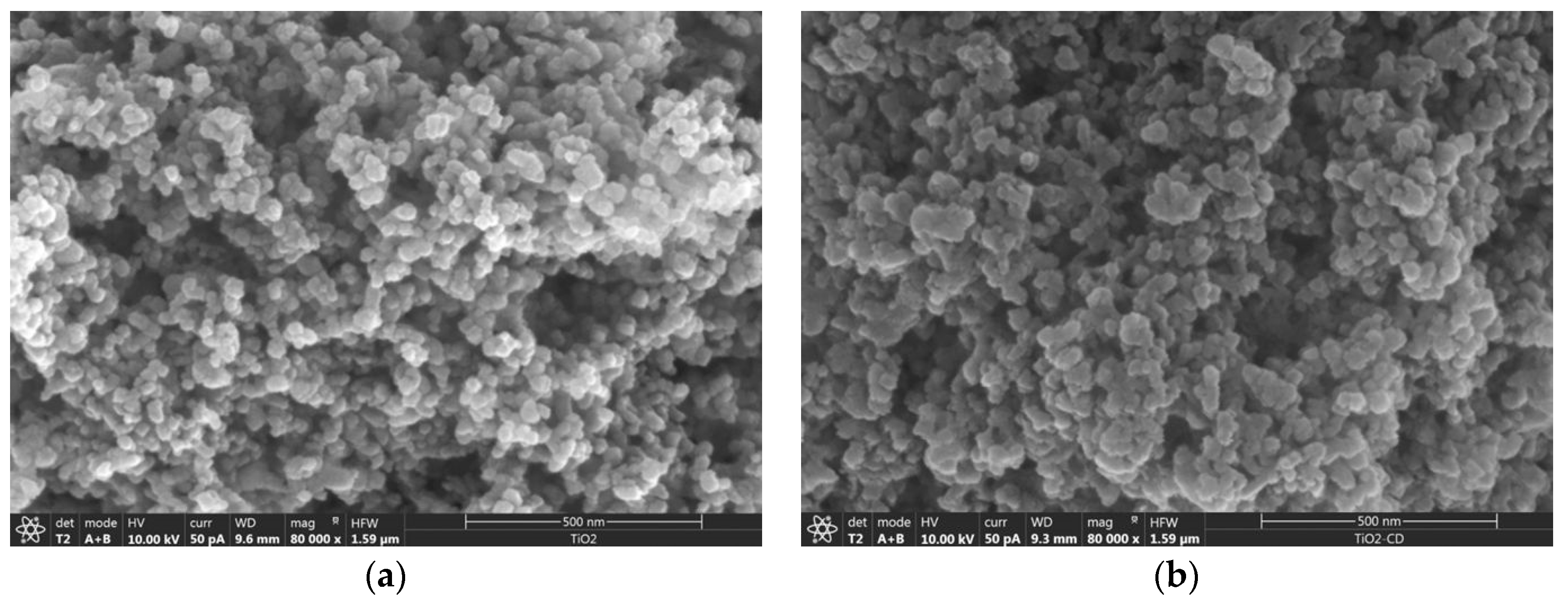
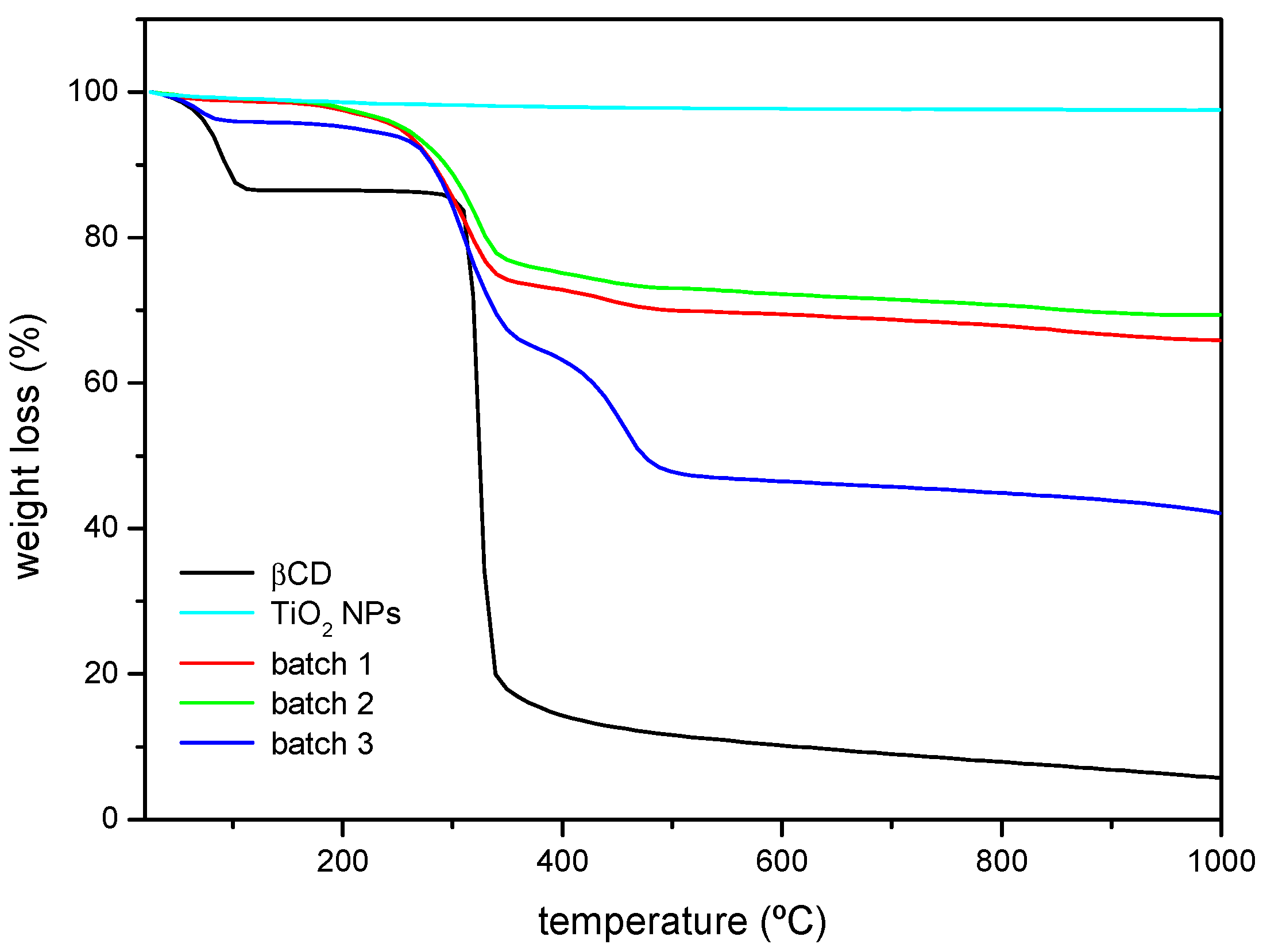
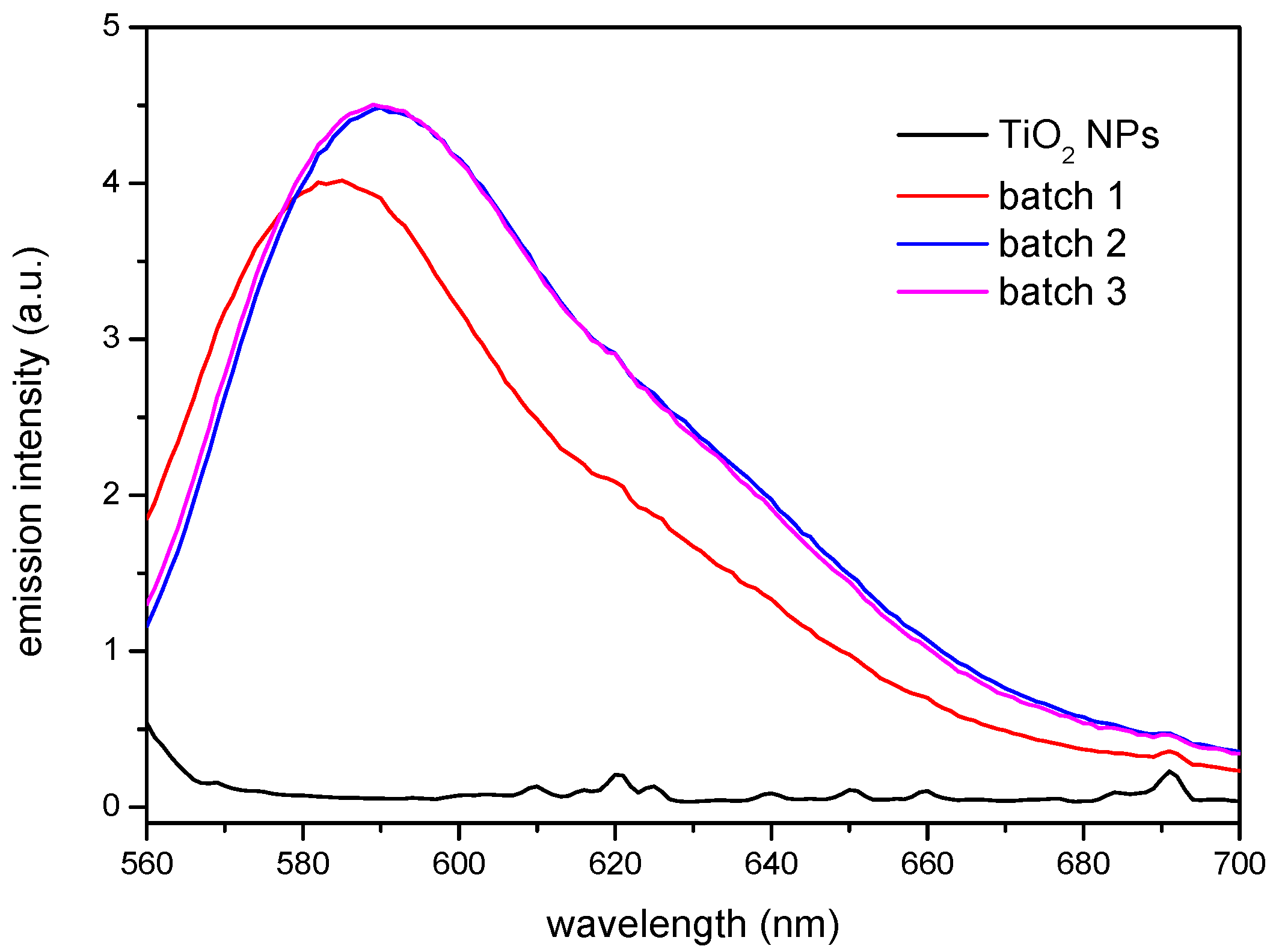
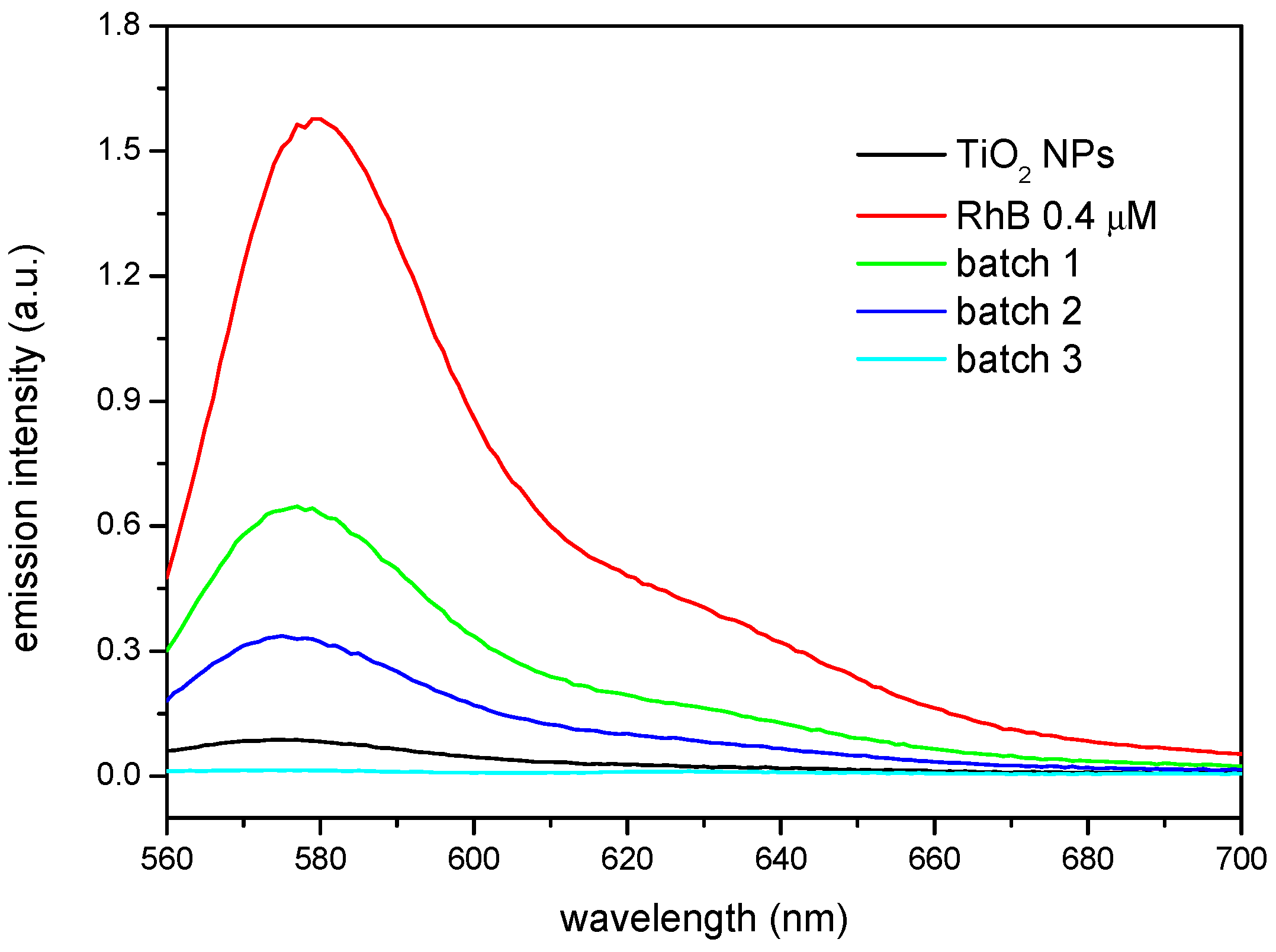
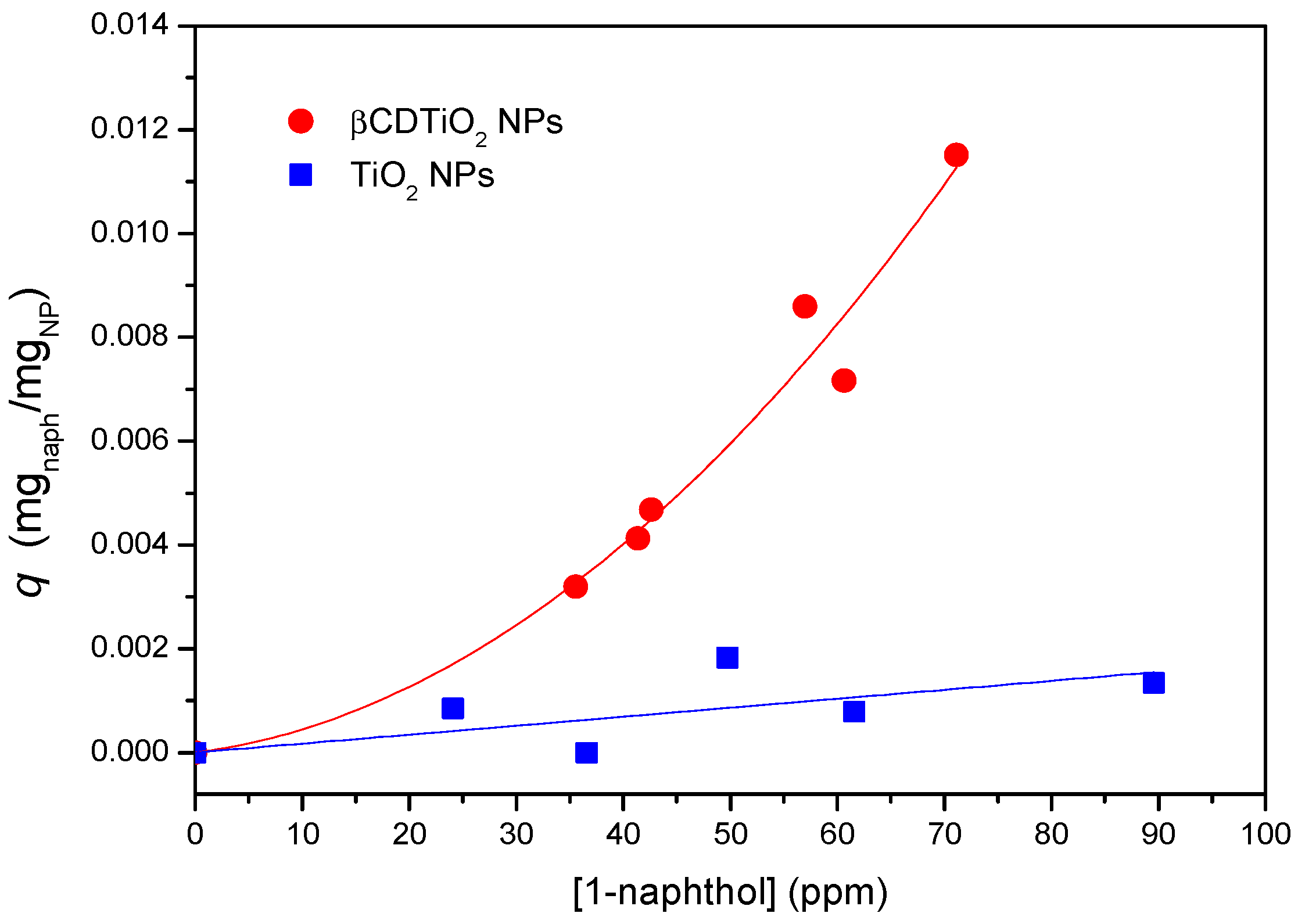
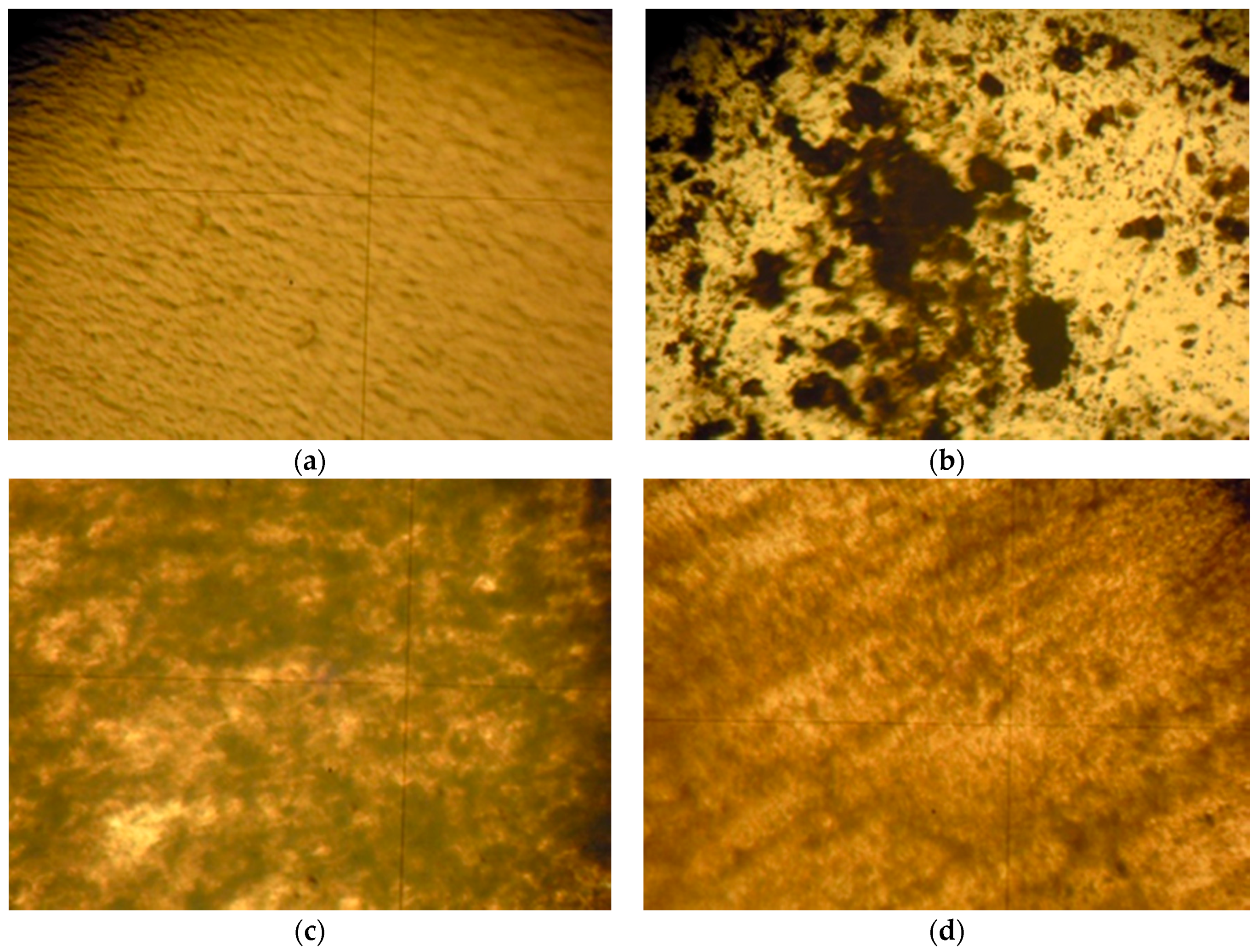
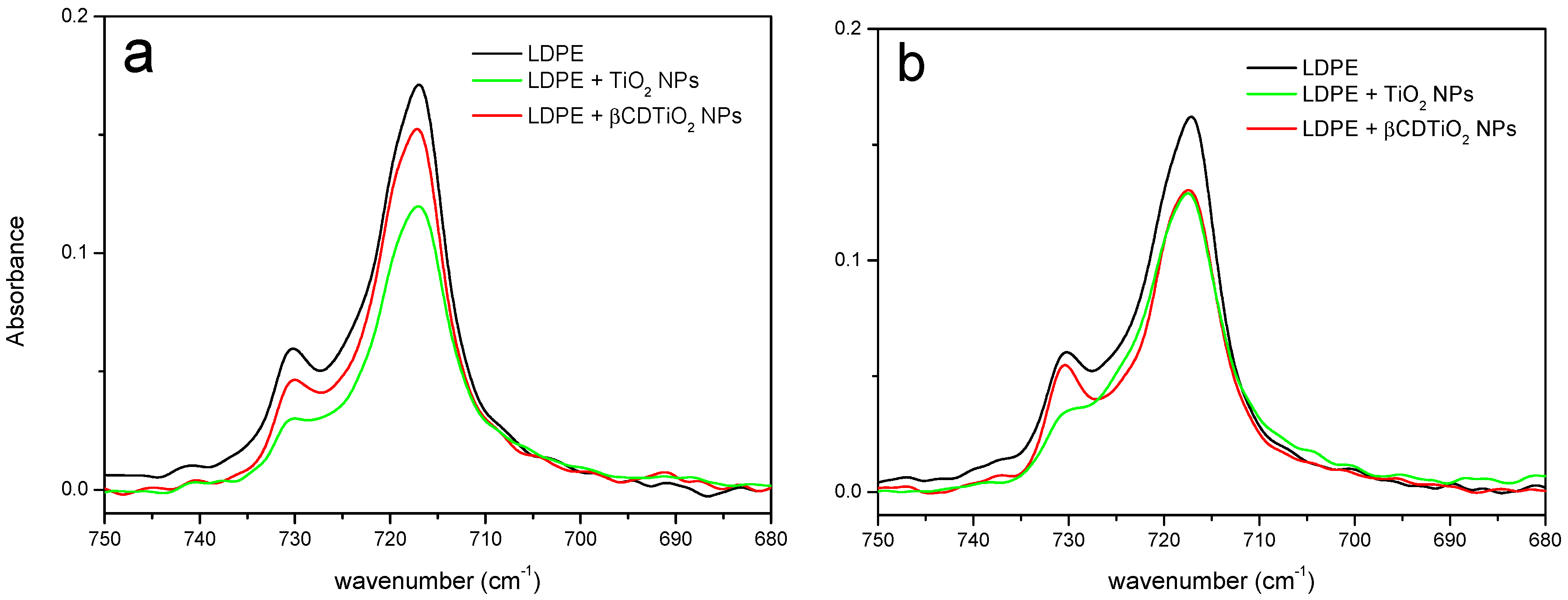

| SAMPLE | Crystallization | Melting | ||
|---|---|---|---|---|
| Tc (°C) | ΔHc (J·g−1 PE) | Tm (°C) | ΔHm (J·g−1 PE) | |
| LDPE | 99.0 (60.7) | 87.7 (6.0) | 111.3 | 109.7 |
| LDPE + 5% TiO2 NPs | 100.1 (61.4) | 80.4 (5.2) | 111.6 | 101.0 |
| LDPE + 1% βCDTiO2 NPs | 99.2 (60.4) | 79.1 (4.7) | 112.0 | 97.1 |
| LDPE + 3% βCDTiO2 NPs | 99.0 (60.6) | 83.3 (4.8) | 112.2 | 105.6 |
| LDPE + 5% βCDTiO2 NPs | 100.8 (61.6) | 82.5 (5.5) | 111.6 | 104.7 |
| SAMPLE | Crystallization | Melting | ||
|---|---|---|---|---|
| Tc (°C) | ΔHc (J·g−1 PEO) | Tm (°C) | ΔHm (J·g−1 PEO) | |
| PEO | 39.6 | 133.9 | 64.5 | 125.9 |
| PEO + 1% TiO2 NPs | 38.9 | 129.8 | 63.5 | 124.8 |
| PEO + 1% βCDTiO2 NPs | 39.5 | 138.7 | 63.8 | 130.8 |
| PEO + 3% TiO2 NPs | 40.7 | 140.4 | 65.2 | 132.7 |
| PEO + 3% βCDTiO2 NPs | 38.9 | 132.1 | 64.4 | 125.8 |
© 2018 by the authors. Licensee MDPI, Basel, Switzerland. This article is an open access article distributed under the terms and conditions of the Creative Commons Attribution (CC BY) license (http://creativecommons.org/licenses/by/4.0/).
Share and Cite
Monreal-Pérez, P.; Isasi, J.R.; González-Benito, J.; Olmos, D.; González-Gaitano, G. Cyclodextrin-Grafted TiO2 Nanoparticles: Synthesis, Complexation Capacity, and Dispersion in Polymeric Matrices. Nanomaterials 2018, 8, 642. https://doi.org/10.3390/nano8090642
Monreal-Pérez P, Isasi JR, González-Benito J, Olmos D, González-Gaitano G. Cyclodextrin-Grafted TiO2 Nanoparticles: Synthesis, Complexation Capacity, and Dispersion in Polymeric Matrices. Nanomaterials. 2018; 8(9):642. https://doi.org/10.3390/nano8090642
Chicago/Turabian StyleMonreal-Pérez, Pablo, José Ramón Isasi, Javier González-Benito, Dania Olmos, and Gustavo González-Gaitano. 2018. "Cyclodextrin-Grafted TiO2 Nanoparticles: Synthesis, Complexation Capacity, and Dispersion in Polymeric Matrices" Nanomaterials 8, no. 9: 642. https://doi.org/10.3390/nano8090642
APA StyleMonreal-Pérez, P., Isasi, J. R., González-Benito, J., Olmos, D., & González-Gaitano, G. (2018). Cyclodextrin-Grafted TiO2 Nanoparticles: Synthesis, Complexation Capacity, and Dispersion in Polymeric Matrices. Nanomaterials, 8(9), 642. https://doi.org/10.3390/nano8090642








